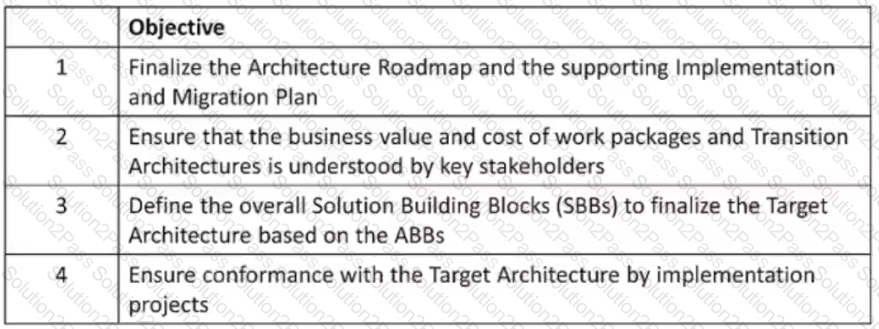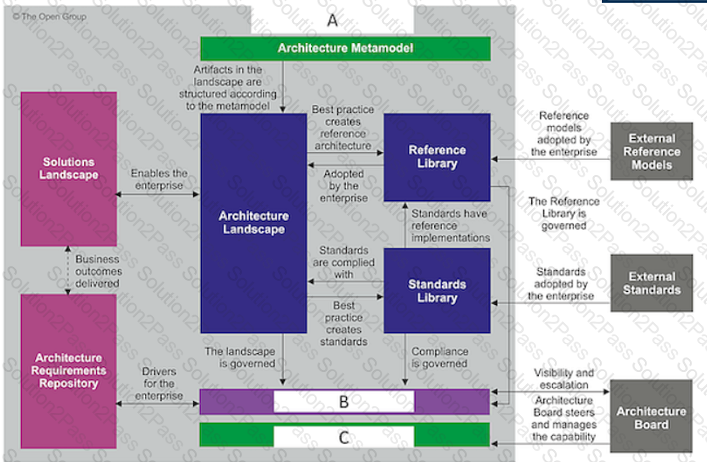OGEA-10B The Open Group TOGAF Enterprise Architecture Bridge Exam (English) Free Practice Exam Questions (2025 Updated)
Prepare effectively for your The Open Group OGEA-10B TOGAF Enterprise Architecture Bridge Exam (English) certification with our extensive collection of free, high-quality practice questions. Each question is designed to mirror the actual exam format and objectives, complete with comprehensive answers and detailed explanations. Our materials are regularly updated for 2025, ensuring you have the most current resources to build confidence and succeed on your first attempt.
Which section of the TOGAF template for Architecture Principles should highlight the requirements for carrying out the principle?
Which of the following best summarizes the purpose of Enterprise Architecture?
Consider the following statement:
Separate projects may operate their own ADM cycles concurrently, with relationships between the different projects
What does it illustrate?
Which of the following does the TOGAF standard describe as a package of functionality defined to meet business needs across an organization?
What is an objective of the ADM Preliminary Phase?
Consider the following ADM phases objectives.

Which phase does each objective match?
Consider the following ADM phases objectives.
Objective:
1.Develop the Target Data Architecture that enables the Business Architecture and the Architecture Vision
2.Develop the Target Business Architecture that describes how the enterprise needs to operate to achieve the business goals
3.Develop a high-level aspirational vision of the capabilities and business value to be delivered as a result of the proposed Enterprise Architecture
4.Identify candidate Architecture Roadmap components based upon gaps between the Baseline and Target Technology Architectures
Which phase does each objective match?
Exhibit:

Consider the illustration. What are the items labelled A, B, and C?
What are the following activities part of?
. Risk classification
. Risk identification
. Initial risk assessment
Complete the sentence. Actions arising from the Business Transformation Readiness Assessment technique should be incorporated in the
Which ADM phase focuses on defining the problem to be solved, identifying the stakeholders, their concerns, and requirements?
Which of the following supports the need to govern Enterprise Architecture?
Which statement about Requirements Management is most correct?
Complete the sentence A business scenario describes______________
Which of the following describes a purpose of Architecture Principles?
Which of the following statements about architecture partitioning is correct?
Please read this scenario prior to answering the question
You are the Lead Enterprise Architect at a major agribusiness company. The company's main harvest is lentils, a highly valued food grown worldwide. The lentil parasite, broomrape, has been an increasing concern for many years and is now becoming resistant to chemical controls. In addition, changes in climate favor the propagation and growth of the parasite. As a result, the parasite cannot realistically be exterminated, and it has become pandemic, with lentil yields falling globally.
In response to the situation, the CEO has decided that the lentil fields will be used for another harvest. The company will also cease to process third-party lentils and will repurpose its processing plants. Thus, the target market will change, and the end-products will be different and more varied.
The company has recently established an Enterprise Architecture practice based on the TOGAF standard as method and guiding framework. The CIO is the sponsor of the activity. A formal request for architecture change has been approved. At this stage there is no fixed scope, shared vision, or objectives.
Refer to the scenario
You have been asked to propose the best approach for architecture development to realize the CEO's change in direction for the company.
Based on the TOGAF standard which of the following is the best answer?
Please read this scenario prior to answering the question
You are working as the Chief Enterprise Architect within a law firm specializing in personal injury cases. Many of the firm's competitors have improved their litigation strategies, and efficiency by streamlining their processes using Artificial Intelligence {Al).
The CIO has approved a Request for Architecture Work to examine the use of Machine Learning in defining a new Al-driven litigation and finance process for the firm. This process would instruct the lawyers and analysts as to what tasks and portfolio they should work on. The key objectives are to increase task profitability, maximize staff utilization, and increase individual profitability.
The CIO has emphasized that the architecture should enable the fast implementation of continuous Machine Learning. The solution will need to be constantly measured for delivered value and be quickly iterated to success.
Some of the partners have expressed concerns about letting the Al make the decisions, others about the risks associated with use of it for the type of service they deliver. The CIO wants to know if these concerns can be addressed, and how risks will be covered by a new architecture enabling Al and Machine Learning.
Refer to the scenario
You have been asked to respond to the CIO recommending an approach that would enable the development of an architecture that addresses the concerns of the CIO and the concerns of the partners.
Based on the TOGAF standard which of the following is the best answer?
